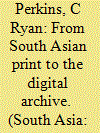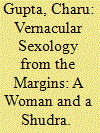|
|
|
Sort Order |
|
|
|
Items / Page
|
|
|
|
|
|
|
| Srl | Item |
| 1 |
ID:
140459


|
|
|
|
|
| Summary/Abstract |
The story of print and religious publics in colonial India has largely been told as one of reformist groups and religious polemics. But this covers only a small part of the story of religious print, which extends well beyond reformist groups. This essay focuses on the most systematic and long-lived project of publishing sant orature (bani), the Santbānī Pustakmālā of the Belvedere Press, Allahabad. It examines its scope, aims and methods as well as its religious orientation and conceptualisation of a religious-devotional public in early-twentieth-century North India. Halfway between oral bhajan groups and the scholarly publications of the collected works (granthavali) of sant poets, throughout the twentieth century the Belvedere Press booklets have commanded tremendous currency as religious print-objects in the Hindi devotional public sphere. The results of one publisher's effort and investment, and of significant reorganisation of material from manuscript sources, these booklets have been extremely popular and lasting products in the extensive market for religious material, clearly a crucial technology for individual and group religious practice (bhajan), before which the lineages' own publishing efforts pale into quasi-insignificance.
|
|
|
|
|
|
|
|
|
|
|
|
|
|
|
|
| 2 |
ID:
172230


|
|
|
|
|
| Summary/Abstract |
This essay examines the challenges involving the creation of and access to digital content and those faced by smaller nineteenth-century publishers in South Asia. Rather than seeing the digital arena of online publishing as representing a break with preceding periods and technologies, this article argues that, as during the period of print’s expansion in colonial India towards the end of the nineteenth century, the digital arena is at its core an ongoing experiment in which legislation and regulations, readers, publishers, libraries, pirates and business interests continue to play off one another in a metaphorical dance through which the digital publishing landscape is created. For those in late colonial India who sought to enter the world of print and for contemporary efforts to make digitised materials available online alike, the quest for fiscal sustainability has been one of the greatest challenges. By combining an examination of the Urdu writer Abdul Ḥalīm Sharar’s (1860–1926) struggles in publishing the monthly periodical, Dil Gudāz, between 1887 and 1934 with the challenges faced by online archives today, this essay teases out parallels and differences. I argue that the ability of smaller presses to thrive in India in the late nineteenth and early twentieth centuries was dependent on a responsive public that accepted its newfound role as patrons, whereas in the present, private donations and grants are the crucial ingredients that can help ensure collaborations achieve their goals.
|
|
|
|
|
|
|
|
|
|
|
|
|
|
|
|
| 3 |
ID:
139684


|
|
|
|
|
| Summary/Abstract |
In India in the 1860s, print was becoming the primary medium for the reproduction of religious texts. The accessibility of print, and its ready uptake within a highly stratified and competitive religious landscape, had a significant effect on the ways in which groups contended for textual, and thus spiritual, authority. In 1867, the popular Tamil Shaiva mystic Ramalinga Adigal and his followers published Tiruvarutpa, a book of Ramalinga's poems that would help establish his reputation as a great Shaiva saint. Ramalinga and his disciples chose to publish the work in a form that shared the content and the material features of contemporaneous publications of Tamil classics, thereby claiming a place for his poems alongside the revered Shaiva canon. They showed an acute awareness that it was not solely the content of religious texts, but also the materiality of the printed object in which texts appeared, that sustained assertions for authority. This article argues that leaders on the margins of established centres of religious power in South India sought authority by exploiting the material aspects of print as the new medium of religious canons.
|
|
|
|
|
|
|
|
|
|
|
|
|
|
|
|
| 4 |
ID:
177195


|
|
|
|
|
| Summary/Abstract |
This article centres on the Hindi sexology writings of a woman, Yashoda Devi, and a Shudra, Santram B.A. In the context of an efflorescence of vernacular sexology literature in early twentieth-century North India, it explicates how their writings moved along different registers, whereby they envisaged a heterosexual ethics that relied on utopian and dystopian descriptions of modernity. Sexology in Hindi, particularly when construed from the margins, reified, constructed, destabilised and questioned sexual norms. The article argues that while largely operating within reformist sexology frames, their writings at times punctured dominant upper-caste, male-centric authority and created frictions in normative equations. Together, their writings contribute significantly to creating a vernacular archive of sexual sciences in India.
|
|
|
|
|
|
|
|
|
|
|
|
|
|
|
|
|
|
|
|
|